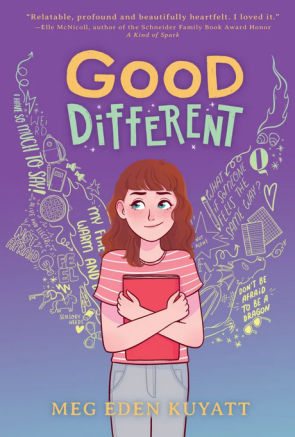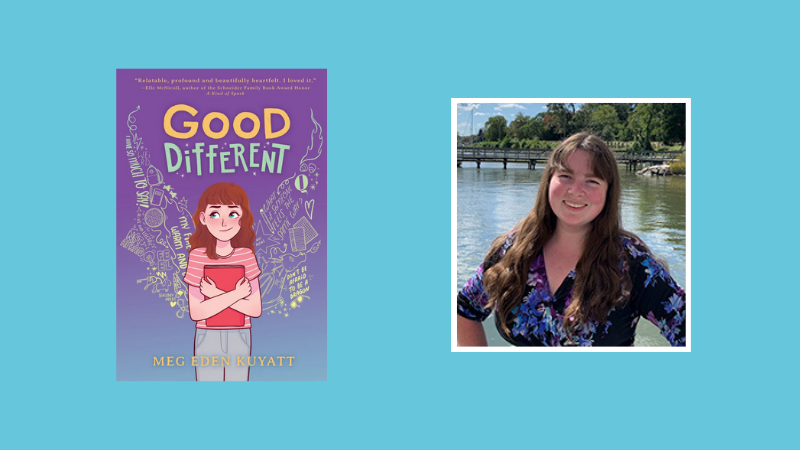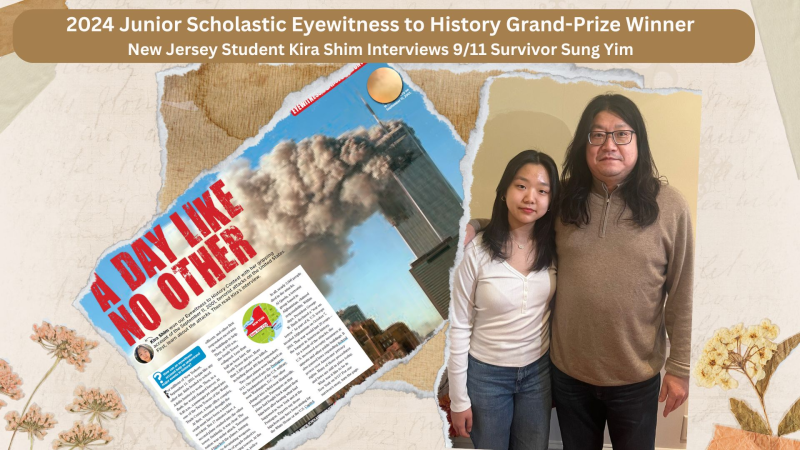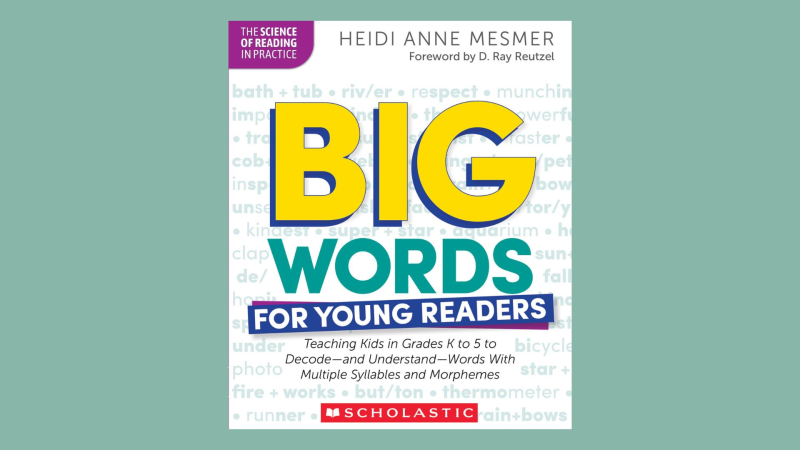This post was written by Brooks Jewell, Director, Scholastic Internal Communications.
 April is Autism Awareness and Acceptance month, so we’ve decided to spotlight Scholastic author Meg Eden Kuyatt and her critically acclaimed novel Good Different.
April is Autism Awareness and Acceptance month, so we’ve decided to spotlight Scholastic author Meg Eden Kuyatt and her critically acclaimed novel Good Different.
In Meg’s book, we are introduced to Selah, a 12-year-old student at Pebblecreek Academy, who suspects she might actually be a dragon stuck in a world of humans who will never understand her. Selah realizes that she is much more sensitive to the outside world than her peers, but she has also learned that expressing the feelings that build up inside her is seen as “wrong.” In elementary school, she is able to take comfort in the rules that she diligently memorizes in order to her keep her “normal face mask” on. She wears this mask all day -- even sometimes at home with her mother. The only person she feels able to be herself with is “Pop,” her outspoken grandpa who seems to share some of her neurodivergent sensitivities.
As Selah becomes older, and the rules of middle school become more fluid, the harder it is for her to make it through the day until she can get to a safe, quiet space to recharge. One fateful afternoon, she reacts and hits a classmate. Suddenly Selah’s “differentness” is now in full view of the whole school. She has to decide whether to hide it away again in order to be accepted – or choose a new path.
We caught up recently with Meg to learn more about her and what inspired her to tell Selah’s story.
You weren’t diagnosed with autism until you were an adult, but when did you first suspect that you didn’t experience the world the same way others did?
I’ve always felt different—but that was always in a good way until college. In college, I was living away from home for the first time, with people who liked to leave the lights on and be loud late at night. In short, people who were very different from me! I had a complete meltdown at my roommate, who kept her desk light on all night, making it difficult for me to sleep. I couldn’t believe it—who does that, I wondered? It just seemed obvious to me that you don’t do something like that (and it never occurred to me that this was something I had the power and agency to communicate, that we could talk and find a solution. I just held it in until I couldn’t). But that’s when I realized people are different and that just because something’s obvious to me doesn’t mean it is to someone else, that just because it bothers me doesn’t mean it bothers everyone. I think that was the first clue to me that maybe I’m different in how this sensory stuff impacts me. It was also in college that I read a book with an autistic-coded protagonist. I realized—wait, other people feel that way too? I designed my own major in college (Cognitive Science and Written Communication), and my thesis project was a novel from the perspective of an autistic girl. I realized in college I resonated with autistic folks, that I might be able to help, but hadn’t quite realized that maybe the reason I connected with them was because I was also autistic!
You made a really touching point about the fact that we often only talk about the disadvantages of autism rather than celebrating the benefits that come with it – what do you want kids to know about those strengths and how they’ve helped you – and in your story, Selah?
I want kids to know those strengths are there! They have strengths to offer the world, things that only they are wired to do. Often, we don’t even realize our strengths because we’re so used to being told only the negatives. But if we can identify our strengths, we can learn how to work with the difficulties—and we can be empowered to use those strengths to make a difference in the world around us! As we edited (Good Different), Emily really encouraged me to dig deeper into what Selah does with her autism, what tools she discovers and how she learns to advocate for herself. I’m so glad for this as I think it gives a great example to kids of what is possible, and how like Selah, they can identify their strengths and self-advocate—and like Toothless with his tail fin, find their own ways to “fly”!
What inspired you to use poetry to tell Selah’s story and how did that approach impact the message you wanted to get across?
We come to poetry when prose is inadequate, when the content can only be in verse. There’s that saying for musical theater, that the characters sing when the emotion’s too strong for spoken word. They dance when the emotion’s too strong for music. Poetry is like that. The emotion has to be so strong that it comes out organically in poetry. And my feelings about being neurodivergent in a neurotypical world, all the exhaustion and overstimulation and confusion of not being able to keep up, the feelings were too big for prose. Selah’s story just popped out in poems for me! I’ve also found that the verse helps readers who are different than Selah better understand an autistic perspective. The verse allows us to more viscerally feel what Selah’s feeling. And that feeling, that helps create empathy for readers. So, my hope is that the verse helps especially neurotypical readers increase in empathy and understanding of different autistic experiences.
We come to poetry when prose is inadequate, when the content can only be in verse. There’s that saying for musical theater, that the characters sing when the emotion’s too strong for spoken word. They dance when the emotion’s too strong for music. Poetry is like that. The emotion has to be so strong that it comes out organically in poetry. And my feelings about being neurodivergent in a neurotypical world, all the exhaustion and overstimulation and confusion of not being able to keep up, the feelings were too big for prose. Selah’s story just popped out in poems for me! I’ve also found that the verse helps readers who are different than Selah better understand an autistic perspective. The verse allows us to more viscerally feel what Selah’s feeling. And that feeling, that helps create empathy for readers. So, my hope is that the verse helps especially neurotypical readers increase in empathy and understanding of different autistic experiences.
Selah works hard to follow the “rules” that help her keep her “normal-face mask” on but there’s a point when she starts to discover that the rules are not only damaging to her – but to other people she thinks of as “normal,” for example her mom putting up with disruptive neighbors to avoid confrontation, or having classmates request copies of her poems because they have felt stifled too – what were you trying to show about Selah’s development at that point?
So many of us neurodivergent girls mask for survival. We think these rules we’ve designed will help us belong and survive in this world not built for us. But they’re unsustainable. They’re not realistic. It’s like trying to follow the instruction manual for a toaster oven when you’re a freezer. I’ve discovered this the hard way. But I wanted Selah to learn this quicker than me, to see that this is the wrong way of going about fixing her problems. To accept her differences and learn to work with them. I wanted to show Selah develop healthier habits and model those to readers.
I also wanted to show Selah’s empathy. There’s this truly bizarre stereotype that autistic people lack empathy, but I wanted to show Selah’s ability to observe those around her, to gain insights on how they’re feeling and to feel with them. I wanted readers to see Selah is highly emotionally developed and push back against this outdated stereotype.
As her journey progresses, Selah decides to make her own rules, my favorite being “if you are a dragon, be a dragon.” This effectively gives her the permission to be herself – what does this say about Selah and what do you want children like her to learn from this?
I talk to a lot of my friends now who, with time and age are beginning to become aware of the ways they masked to survive as kids. The ways they suppressed parts of themselves because they didn’t feel it was safe in one way or another to be themselves. And all of us are still unpacking the damage of that now, years later. I really don’t want that cycle to continue for kids. I want kids to learn to find joy in how their brains work, even if there are also difficulties.
In the acknowledgements, you thank God for making your brains the way they are, which is such a powerful example of self-love and acceptance – something everyone can learn from, do you have any advice on how to quiet the negative voice we all have inside?
I love this question! The negative voices are still there, unfortunately! But they get quieter, or perhaps I’m learning how to push them to the background a bit. I am learning that reminding myself what is true is critical. I know that I am fearfully and wonderfully made. I know that what I’ve been given is a purposeful, intentional choice. I don’t always understand why, but if I try to focus on what I know—instead of the doubts, insecurities and fears I at times feel—this encourages me to persist. I have potential and possibility. I have a job to do in just living out who I am. And what a cool job that is!
Is there anything else about Selah, her story, or your journey that you’d like to share?
I’d just love to thank Scholastic for seeing Selah’s story and giving her the opportunity to go out into the world! I am so thrilled to already be hearing readers resonate with her story.






